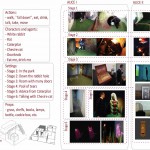PhD thesis, by Marija Nakevska
 Immersive and interactive Storytelling is a form of digital entertainment in which an actual narrative is recreated into highly immersive and interactive fictional worlds where a user can have the experience of being a character in a story that unfolds based on her actions. We take advantage of novel technologies, by merging real and virtual worlds to produce new environments that confront the user in an intense and a seemingly real experience. The user is physically immersed in the narrative, co-creates the story, and interacts with the space instead of watching on a screen.
Immersive and interactive Storytelling is a form of digital entertainment in which an actual narrative is recreated into highly immersive and interactive fictional worlds where a user can have the experience of being a character in a story that unfolds based on her actions. We take advantage of novel technologies, by merging real and virtual worlds to produce new environments that confront the user in an intense and a seemingly real experience. The user is physically immersed in the narrative, co-creates the story, and interacts with the space instead of watching on a screen.
This research is part of the project ALICE which creates an experience based on selected parts from the novel ”Alice’s Adventures in Wonderland” by L. Carroll. The ALICE installation covers two floors each with an area size of 12 by 12 meters, and it comprises six separate stages, each of them using a large palette of technologies, such as sensors, actuators, virtual reality, and embodied and virtual agents. Each stage of the installation utilizes a dedicated space that simulates a certain environment, e.g., nature mimicking, simulation of falling, or changes of the perception
of the relative size of the space, which correspond to different parts of the narrative.
This thesis explores the design challenges that concern the building of this type of immersive and interactive environments. The research was done in a close cooperation with designers, architectural, electrical and mechanical engineers. Design knowledge was acquired from the fields of computer science, interaction design, and psychology to identify the design challenges and the software and hardware requirements. The overall goal is to equip the design and the development teams with empirical knowledge, software tools and unified development environment that supports the process of creating interactive immersive environments.
The thesis is organized in three parts. In part one, we give overview on the developments of interactive storytelling in mixed reality environments. A theoretical overview of the established narrativetheories is provided,that help usto define atheoretical model of the core story elements and the spatial and temporal relations. A technical state of the art overview presents the palette of technologies that allow merging of real and virtual worlds.
In the second part, we present the practical explorations in the ALICE project, we reflect on the design and development process and we propose a design tool to support the design process.
Three stages from the ALICE installation are redesigned; reflection on the research objectives related to the system (technological objectives) and to the user experience (socio-cultural objectives) is presented. The design process in the ALICE project gave input for creating a design
toolthat supportsthe design and development process of such installations. The tool named ”Tell me a Story!”is presented and the usage of the tool and the altered design process is demonstrated through a case study.
In the third part, we give a theoretical ground for understanding the user experience in interactive stories in mixed reality environments. Empirical evidence about the user experience in the ALICE installation is presented in two studies. The first study investigates the effects of sound design and user’s preknowledge of the story, and the second study looks into the effect of interactivity on the user experience and the behavior of the participants. Finally, we notice that the experience provided in the ALICE installation was very much appreciated and positively evaluated by over than 100 participants. We see great potential in this type of interactive entertainment.